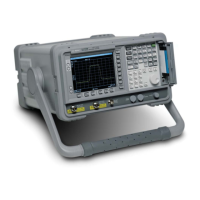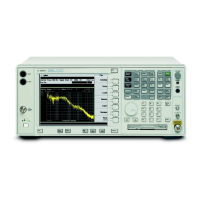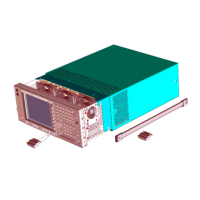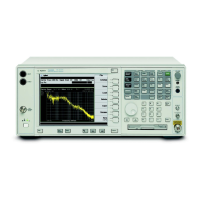Chapter 2 123
Front-Panel Key Reference
Marker
Function Accesses the following marker function menu keys listed below.
Key Access:
Marker, More
Band Power
Indicates the power over that part of the trace between
the reference and active markers. If only one marker is
present when you press
Band Power, a second marker is
placed at the same location as the first marker. To
reposition the markers, press
Marker to access Delta Pair
and
Span Pair keys. If Detector (Auto) is selected,
average detection is used for RBW
≥
1 kHz, and Sample
detection is used for RBW
<
1 KHz.
Key Access:
Marker, More, Function
NOTE For best accuracy, set the video bandwidth to at least ten times the
resolution bandwidth to minimize its averaging effect.
NOTE Band Power has no meaning in zero span, and the indicated value is
independent of signal level and marker placement.
Marker Noise Reads out the average noise level, referenced to a 1 Hz
noise power bandwidth. If no marker is present, a
marker appears at the center of the display. When
Marker Noise is enabled in resolution bandwidths of
1 kHz and above, the auto coupled detector selection is
set to Average and the Avg Type is set to Power because
the trade-off between sweeptime and variance of the
result is best with power Average detection. In
resolution bandwidths < 1 kHz, the auto coupled
detector selection is Sample. However, the Marker
Noise function generates appropriately corrected values
for all supported detector modes. If the marker delta
function is on and the noise marker is activated and
moved to measure the noise floor, the marker readout
will display the signal-to-noise ratio.
NOTE You can use Delta and Marker Noise to indicate noise level relative to
sinusoidal signal (signal to noise). However, be sure to activate the
delta marker before pressing
Marker Noise or the reference marker units
may be incorrect.
The noise marker averages 5% of the trace data values
(one-half a horizontal division), centered on the location
of the marker on the frequency or time scale. Marker
noise indicates noise power density per Hertz or noise
voltage per root Hertz depending upon the amplitude
units selected. The number of sweep points is noted in
parenthesis to the right of the sweep time in the lower
right corner of the graticule.

